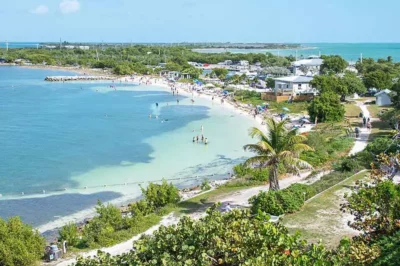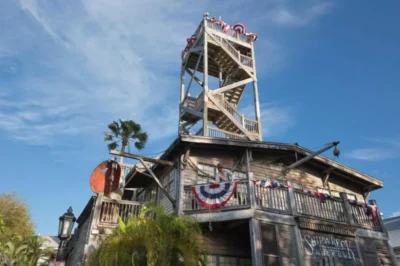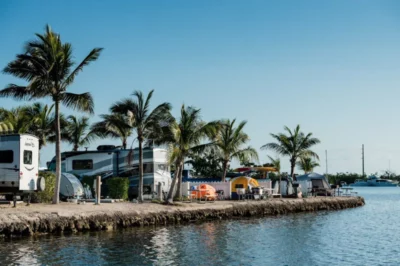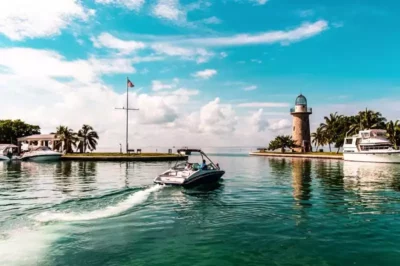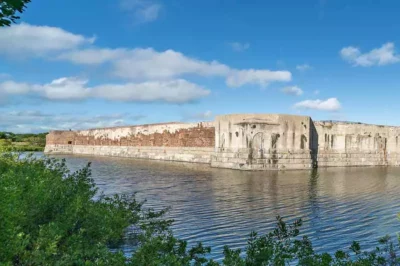- Dry Tortugas History
- Things to Do at the National Park
- Snorkeling and Diving
- Guided Tours of Fort Jefferson
- Birdwatching and Wildlife Spotting
- Kayaking and Paddleboarding
- Reefs and Shipwrecks
- Beaches to Swim
- Camping and Stargazing
- Best Time to Visit
- Weather and Preparedness for Visiting
- The Climate and Weather
- Navigating Through the Hurricane Season
Dry Tortugas National Park: Amazing 1 Day Trip for Snorkeling & Scuba Diving
Dry Tortugas National Park, a hidden gem nestled about 70 miles west of Key West, Florida, is a truly breathtaking and remote destination.
This picturesque park, encompassing seven small islands and mesmerizing turquoise waters, is renowned for its abundant marine life, unspoiled coral reefs, and migratory birds.
At the heart of the park lies the magnificent Fort Jefferson, an enormous 19th-century coastal fortress that provides a fascinating historical backdrop amidst the otherwise tranquil surroundings.
Dry Tortugas History
The history of Dry Tortugas dates back to 1513 when Spanish explorer Juan Ponce de León discovered the islands during his search for the Fountain of Youth. He named them Las Tortugas due to the large number of sea turtles found in the area, and the term Dry was later added to warn mariners of the lack of freshwater sources.
Over the centuries, the strategic location of the islands caught the attention of various governments and military forces, including the United States. In the mid-19th century, the United States began constructing Fort Jefferson to protect its Gulf of Mexico shipping routes and to serve as a potential naval base.
The fort, which took several decades to complete, was built using over 16 million bricks, making it one of the largest brick structures in the Americas.

Although it never saw any major battles, Fort Jefferson served as a military prison during the Civil War, most notably housing Dr. Samuel Mudd, who was convicted for his involvement in the assassination of President Abraham Lincoln. John Wilkes (Booth was the actual assassin, and this inclusion seems misplaced without direct context to Dry Tortugas, as Mudd was the prisoner related to the assassination plot).

In 1935, President Franklin D. Roosevelt declared the area Fort Jefferson National Monument. It was not until 1992 that the Dry Tortugas was recognized as a national park, emphasizing the protection of its unique marine and terrestrial ecosystems as well as its cultural heritage.
Today, Dry Tortugas National Park is a sought-after destination for history buffs, nature enthusiasts, and adventure seekers alike, offering a unique blend of natural beauty and historical significance, almost 70 miles from Key West and accessible only by boat or seaplane, highlighting its status as one of the most remote national parks.
Visitors can explore the 19th-century fort, snorkel in the clear blue waters, and observe the diverse wildlife on Bush Key and the other six islands that make up the 100-square mile park.
Things to Do at the National Park
There is a wide range of activities to enjoy at Dry Tortugas National Park, catering to visitors with diverse interests. Here is a more detailed look at some popular activities that you can experience during your visit:
Snorkeling and Diving
The park’s clear waters and vibrant coral reefs make it a fantastic destination for snorkeling and diving enthusiasts. You can explore the diverse marine life, including colorful fish, sea turtles, and even shipwrecks.
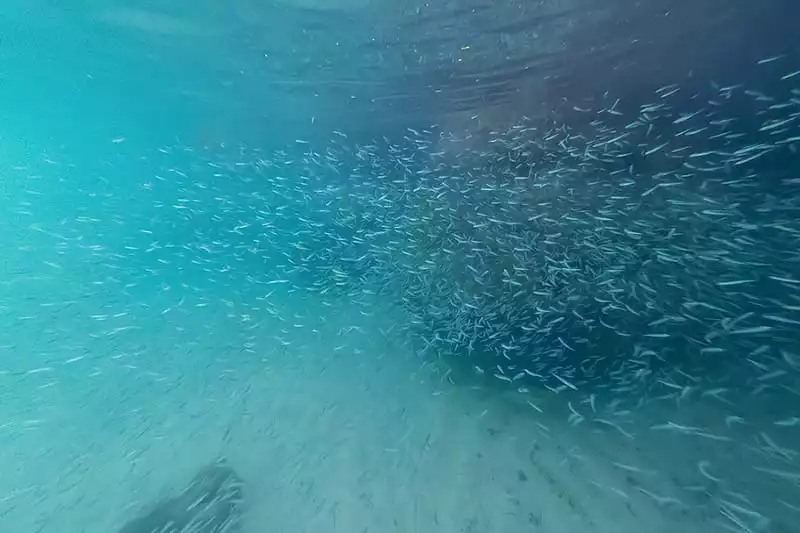
For certified divers, there are various dive sites around the park, such as Windjammer Wreck and Texas Rock, offering different levels of challenge and excitement.
Guided Tours of Fort Jefferson
To gain a deeper understanding of the fort’s history and significance, join a guided tour led by knowledgeable park rangers.
These tours provide insights into the architectural marvel, the lives of the people stationed there, and the fort’s role in American history. The tours are usually free and do not require reservations, making them an accessible option for most visitors.
Birdwatching and Wildlife Spotting
Dry Tortugas National Park is a vital nesting site and resting stop for numerous bird species during their migration. Birdwatching enthusiasts can spot various seabirds, such as sooty terns, brown noddies, and magnificent frigatebirds, especially during the spring and fall migrations.
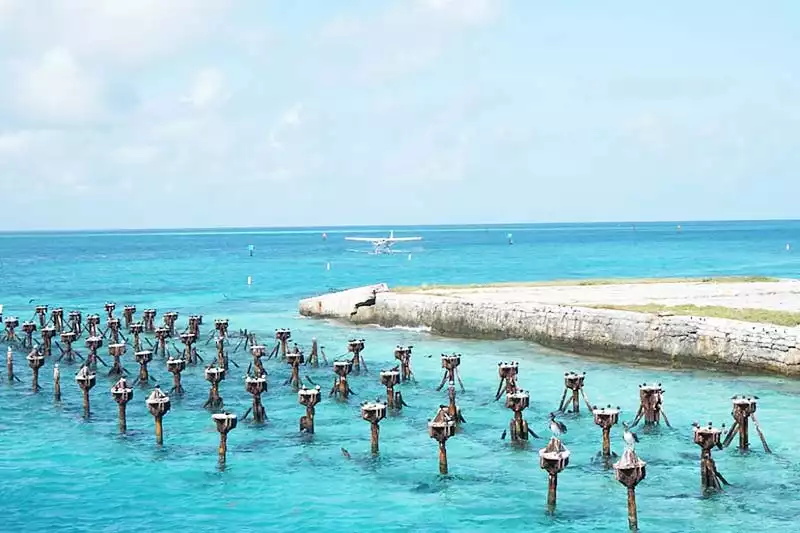
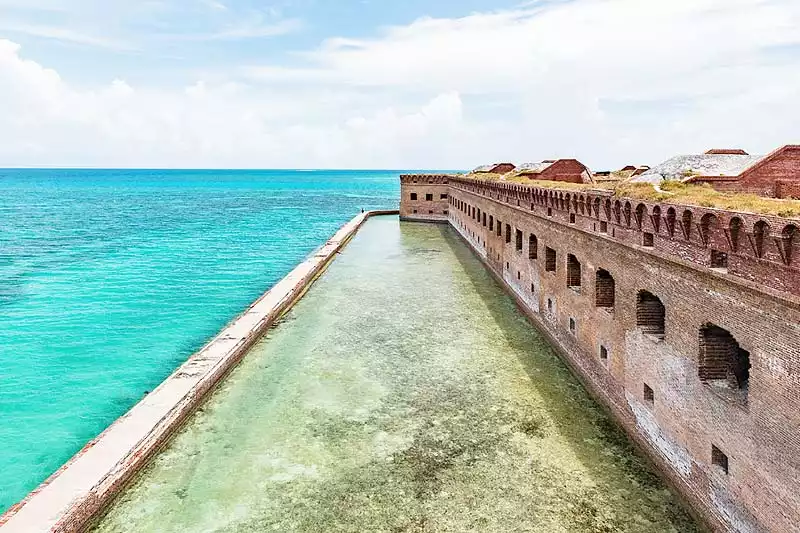
Keep an eye out for other wildlife, too, like sea turtles nesting on the beaches during the summer months and various marine creatures swimming in the surrounding waters.
Kayaking and Paddleboarding
Visitors can bring their own kayaks or paddleboards to explore the park’s waters at a leisurely pace. Paddling around the islands offers a different perspective of the park and the chance to discover hidden coves and secluded beaches. Be aware that there are no rental facilities within the park, so plan accordingly.
Remember that Dry Tortugas National Park is a protected area, so be sure to follow park rules and guidelines, practice Leave No Trace principles, and respect the park’s wildlife and ecosystems during your visit.
Reefs and Shipwrecks
The coral reefs and shipwrecks at Dry Tortugas National Park are significant attractions for visitors, especially those interested in snorkeling, diving, and exploring the rich marine ecosystem.
Reefs: The park is home to numerous living coral reefs that are part of the Florida Reef System, the third largest barrier reef system in the world.
These reefs provide shelter and food for a wide variety of marine life, including colorful fish, sea turtles and a variety of invertebrates such as sponges, corals and crustaceans.
Reefs are a critical component of the park’s ecosystem, providing habitat for a variety of species and protecting islands from wave action and erosion.
Some popular reef sites around the park include Pulaski Shoal, Texas Rock and Long Key Reef, each offering different snorkeling and diving experiences.
Shipwrecks: Dry Tortugas National Park has a long history of shipwrecks, mainly due to its strategic location along major shipping routes and its treacherous surrounding waters, with shallow reefs and unpredictable currents.

Over 200 shipwrecks have been documented in the park’s waters, dating back to the early 17th century. These shipwrecks have become artificial reefs, creating habitats for various marine species and attracting divers from around the world.
Beaches to Swim
Dry Tortugas National Park has many beautiful beaches that offer opportunities for both relaxation and recreation. These include South Swim Beach, Dinghy Beach and North Swim Beach, each with its own unique features and amenities.

South Swim Beach is a popular destination for visitors due to its proximity to the ferry dock and Fort Jefferson.
This beach provides a safe swimming area and is an ideal spot for snorkeling with easy access to nearby coral reefs. The crystal clear waters and soft sands make it the perfect place to sunbathe and enjoy the scenery.
Dinghy Beach, located on the eastern side of Garden Key, is a small beach primarily used by boaters who anchor in the harbor.
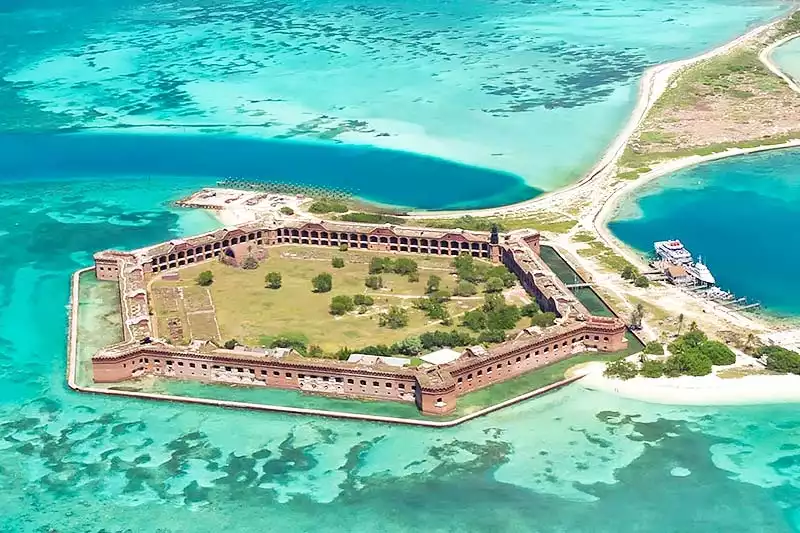
This beach provides a convenient spot for boaters to unload their dinghies and access the island. While not as popular for swimming and sunbathing as the other beaches, it still offers a peaceful setting and beautiful views.
North Swim Beach, situated on the northern side of Garden Key, is another excellent spot for swimming and snorkeling.
The beach is more secluded and less crowded compared to South Swim Beach, making it a great choice for visitors seeking a quieter experience. It’s important to note that there are no lifeguards on duty at any of the park’s beaches, so visitors should exercise caution when swimming and snorkeling.
Camping and Stargazing
For a truly immersive experience, consider camping at Garden Key, the only island within the park where camping is allowed.
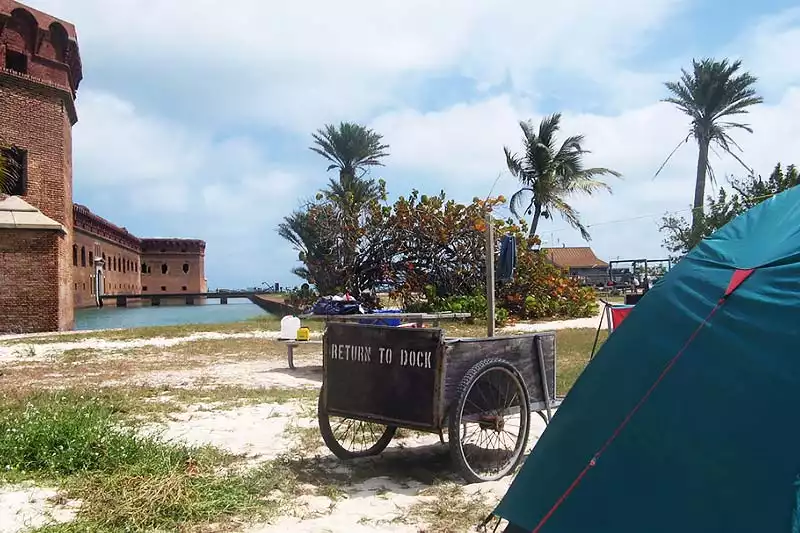
With a limited number of campsites and basic facilities, camping here offers a unique opportunity to enjoy the tranquility of the park after day visitors have left.
The remote location also makes it an ideal spot for stargazing, with minimal light pollution allowing for breathtaking views of the night sky.
Best Time to Visit
The best time to visit Dry Tortugas National Park largely depends on your interests and the activities you’d like to experience.
Generally, the late fall to early spring months (November – April) offer cooler and more comfortable temperatures, ideal for exploring Fort Jefferson and enjoying the park’s natural beauty.
During this time, the park also serves as a hub for migratory birds, making it a perfect time for birdwatching.
However, if you prefer warmer temperatures and water-based activities like snorkeling and swimming, late spring to summer months (May – August) might be more suitable.
Keep in mind that the Atlantic hurricane season runs from June through November, so it’s crucial to monitor weather forecasts and plan your visit accordingly.
Regardless of the time of year, Dry Tortugas National Park provides a stunning experience with its unique blend of history, wildlife, and natural beauty.
Weather and Preparedness for Visiting
The Climate and Weather
Florida Keys, the guardian to this amazing park, is a haven for sun worshippers, offering a pleasant climate year-round.
Only occasionally does the tranquility get interrupted when a hurricane or a tropical storm decides to make a brief appearance. So, when planning your adventure to the Dry Tortugas, it’s best to check the weather forecast a day prior to ensure smooth sailing.
When the sun smiles at the Keys, it’s quite a sight. Temperatures usually range from the comfortable 70s to the warm 80s, creating an idyllic environment for explorers.
Even in the colder months, the islands tend to remain warmer than mainland Florida, offering an extended summer of sorts.
However, don’t underestimate the power of the sun’s rays here. The only refuge from the piercing sunshine is the historic Fort Jefferson with its thick brick corridors.
Navigating Through the Hurricane Season
Although summer is synonymous with vacation, it also brings the hurricane season (June through November) in this part of the world. Staying informed about the weather reports and hurricane tracking becomes crucial during these months.
The operators of the Dry Tortugas ferry ensure the utmost safety of their passengers, not venturing out in adverse weather conditions.
However, for those brave souls planning to navigate the waters on their own, it’s crucial to stay vigilant. Keep a close eye on the potential weather systems that might compromise your safety.
How to Get to Dry Tortugas National Park
There are two main ways to reach Dry Tortugas National Park: by ferry or seaplane. Both options depart from Key West, Florida, and offer unique experiences while traveling to the park. Here’s a detailed look at each transportation option:
By ferry: The Yankee Freedom III is the official ferry service that transports visitors from Key West to Dry Tortugas National Park. The high-speed catamaran offers a comfortable journey, with air-conditioned interiors, an observation deck, and a snack bar.
The ferry departs daily from Key West at 8:00 am, with boarding starting at 7:00 am. The trip to the park takes approximately 2.5 hours, covering the 70-mile journey across the Gulf of Mexico.
Along the way, you may have the opportunity to spot dolphins, sea turtles, and various seabirds. Once at the park, you will have around 4.5 hours to explore and enjoy the various activities before departing back to Key West at 3:00 pm.
The ferry fare includes park entrance fees, a guided tour of Fort Jefferson, breakfast, lunch, and complimentary use of snorkeling gear. Advanced reservations are highly recommended due to limited capacity and high demand, especially during peak travel seasons.
By seaplane: For a more exclusive and thrilling experience, you can choose to travel to Dry Tortugas National Park via seaplane. Key West Seaplane Adventures is the authorized provider of seaplane service to the park.
The seaplane journey offers breathtaking aerial views of the islands, coral reefs, and the historic Fort Jefferson.
Seaplane trips are available in half-day (4 hours) or full-day (8 hours) excursions. The flight itself takes about 40 minutes each way, providing more time to explore the park compared to the ferry option.
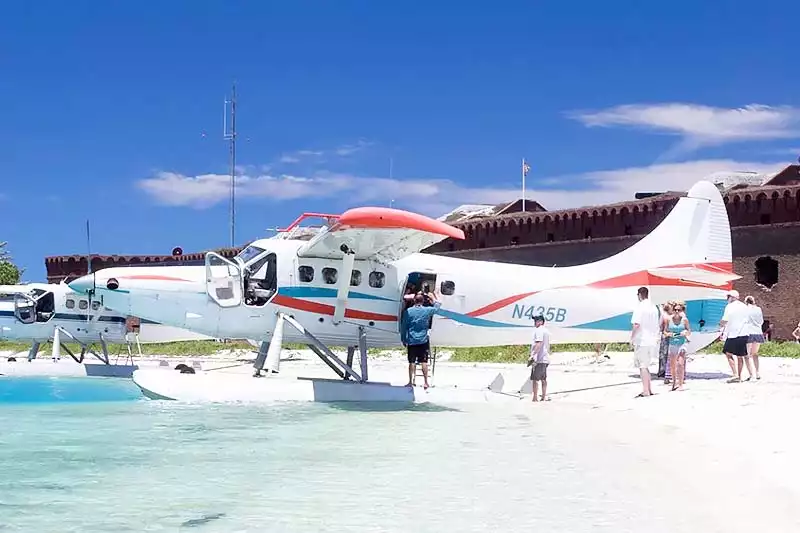
The seaplane fare includes park entrance fees, a guided tour of Fort Jefferson, and complimentary use of snorkeling gear. Note that the seaplane option is more expensive than the ferry, but it offers a unique perspective and faster travel time.
Due to the limited capacity of seaplanes, it’s essential to book your flights well in advance, especially during peak travel seasons.
Regardless of your choice of transportation, visiting Dry Tortugas National Park promises to be an unforgettable experience. Each mode of travel offers a unique perspective on the park’s beauty and remote location, ensuring that the journey itself is just as memorable as the destination.
FAQs
Can you drive to Dry Tortugas National Park?
It’s important to note that you cannot drive to Dry Tortugas National Park, given its location approximately 70 miles west of Key West, Florida. Accessible only by ferry or seaplane, the park comprises seven small islands surrounded by the Gulf of Mexico, making it unreachable by car.
Cheapest way to get to Dry Tortugas National Park
The cheapest way to get to Dry Tortugas National Park is by taking the Yankee Freedom III ferry service.
This high-speed catamaran departs daily from Key West, and the fare includes park entrance fees, a guided tour of Fort Jefferson, breakfast, lunch, and complimentary use of snorkeling gear. Although the seaplane option offers a unique and faster travel experience, it is more expensive compared to the ferry.
Loggerhead Key
Loggerhead Key, the largest and westernmost island in Dry Tortugas National Park, is a unique destination known for its pristine beaches, vibrant coral reefs, diverse marine life, and the historic Loggerhead Lighthouse.
Built in 1858, the lighthouse still stands tall at the center of the island. Another unusual feature of the island is a broken house on the beach.
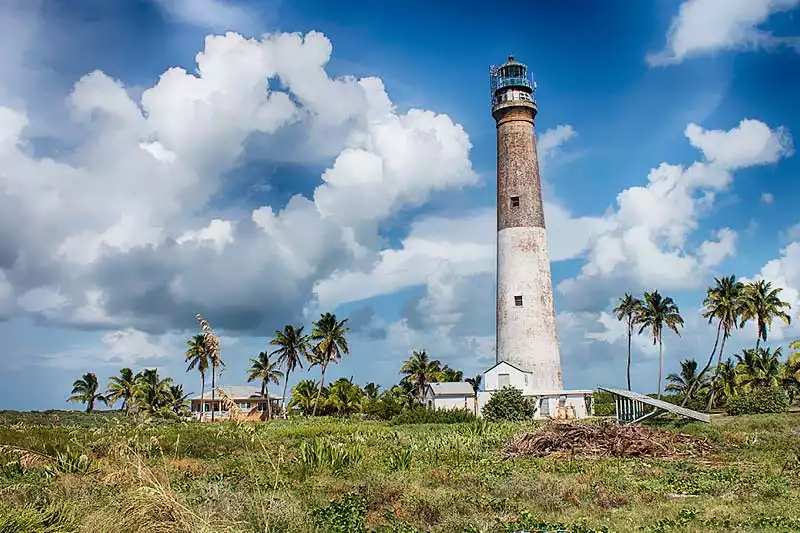
Access to Loggerhead Key is not included in ordinary tour routes and requires a private boat or special arrangements with authorized tour operators. Typically, private boats drop visitors off, allowing them some time to explore before returning to pick them up.
While visiting Loggerhead Key, named after the loggerhead sea turtles that frequent the area, it is essential to respect the delicate ecosystems and follow park regulations to help preserve its natural beauty. For more information on visiting Loggerhead Key, including details, prices, and conditions, visit the National Park Service website at nps.gov.
Conclusion
In summary, Dry Tortugas National Park is an enchanting and secluded destination that offers visitors an extraordinary fusion of natural beauty, thriving marine life, and rich history.
With a variety of activities to partake in, such as snorkeling, birdwatching, and exploring Fort Jefferson, this park guarantees a memorable experience for all who journey to its shores.
